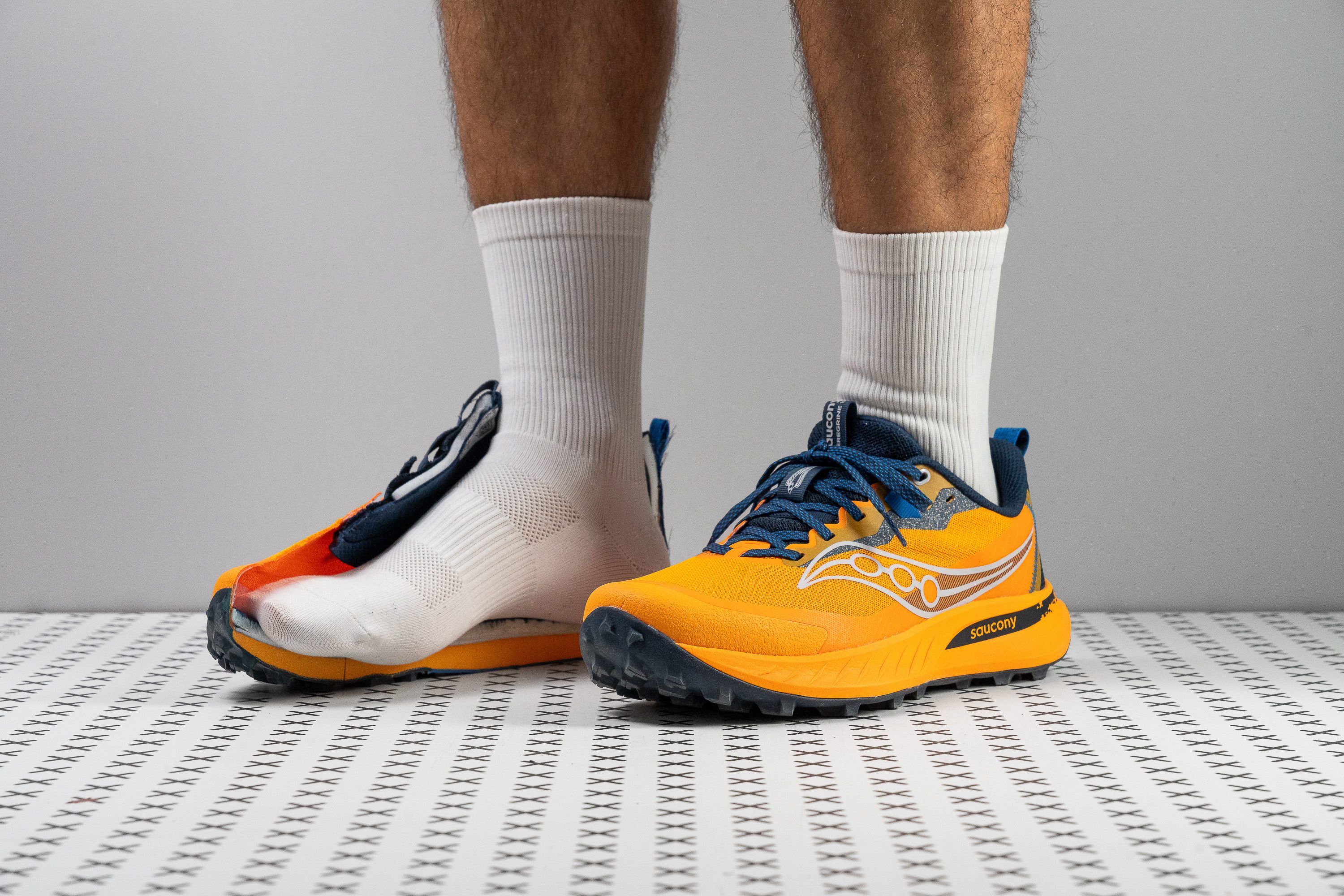Our verdict
Pros
- Plush PWRRUN midsole
- Improved energy return
- Versatile 4.7-mm lugs
- Ready for hiking
- Reasonable price
- Premium PWRRUN+ insole
- Good fit for trail running
- Still lightweight for its size
Cons
- Narrow toebox
- Low drop not ideal for heel strikers
- Could use better breathability
Audience verdict
Comparison
The most similar running shoes compared
+ + Add a shoe | |||||
|---|---|---|---|---|---|
| Audience score | 77 Decent! | 77 Decent! | 90 Superb! | 89 Great! | |
| Price | $140 | $160 | $150 | $140 | |
| Trail terrain | LightModerate | LightModerate | ModerateTechnical | ModerateTechnical | |
| Shock absorption | Moderate | Moderate | - | Low | |
| Energy return | Moderate | Moderate | - | Low | |
| Traction | - | High | - | - | |
| Arch support | Neutral | Neutral | Neutral | Neutral | |
| Weight lab Weight brand | 9.4 oz / 266g 9.7 oz / 275g | 9.2 oz / 261g 9.3 oz / 263g | 10.2 oz / 288g 10.1 oz / 286g | 9.6 oz / 271g 10.2 oz / 290g | |
| Drop lab Drop brand | 3.7 mm 4.0 mm | 3.7 mm 5.0 mm | 4.4 mm 3.0 mm | 3.0 mm 4.0 mm | |
| Strike pattern | Mid/forefoot | Mid/forefoot | Mid/forefoot | Mid/forefoot | |
| Size | True to size | True to size | True to size | True to size | |
| Midsole softness | Soft | Soft | Soft | Soft | |
| Difference in midsole softness in cold | Small | Big | Normal | Normal | |
| Plate | Rock plate | Rock plate | ✗ | ✗ | |
| Toebox durability | Good | Very good | Very good | Good | |
| Heel padding durability | Decent | Good | Decent | Decent | |
| Outsole durability | Good | Good | - | Good | |
| Breathability | Moderate | Breathable | Moderate | Warm | |
| Width / fit | Medium | Medium | Medium | Medium | |
| Toebox width | Narrow | Wide | Medium | Medium | |
| Stiffness | Moderate | Moderate | Stiff | Moderate | |
| Torsional rigidity | Flexible | Flexible | Moderate | Stiff | |
| Heel counter stiffness | Moderate | Moderate | Moderate | Flexible | |
| Lug depth | 4.7 mm | 3.3 mm | 4.4 mm | 4.0 mm | |
| Heel stack lab Heel stack brand | 29.5 mm 28.0 mm | 28.3 mm 29.0 mm | 30.1 mm 31.0 mm | 27.6 mm 31.0 mm | |
| Forefoot lab Forefoot brand | 25.8 mm 24.0 mm | 24.6 mm 24.0 mm | 25.7 mm 28.0 mm | 24.6 mm 27.0 mm | |
| Widths available | NormalWide | Normal | Normal | Normal | |
| Season | All seasons | SummerAll seasons | All seasons | Winter | |
| Removable insole | ✓ | ✓ | ✓ | ✓ | |
| Orthotic friendly | ✓ | ✓ | ✓ | ✓ | |
| Ranking | #331 Bottom 11% | #334 Bottom 10% | #37 Top 10% | #97 Top 27% | |
| Popularity | #128 Top 35% | #262 Bottom 29% | #300 Bottom 19% | #221 Bottom 40% |
Who should buy
After testing it on trails and in the lab, we found that the Saucony Peregrine 15 is great for:
- Runners looking for a no-frills, low-drop trail shoe at a fair price.
- Those wanting one trail shoe for everything: from smooth paths to rocky terrain.
- Peregrine fans ready to upgrade. It delivers with a softer midsole and thoughtful updates, all at the same price.
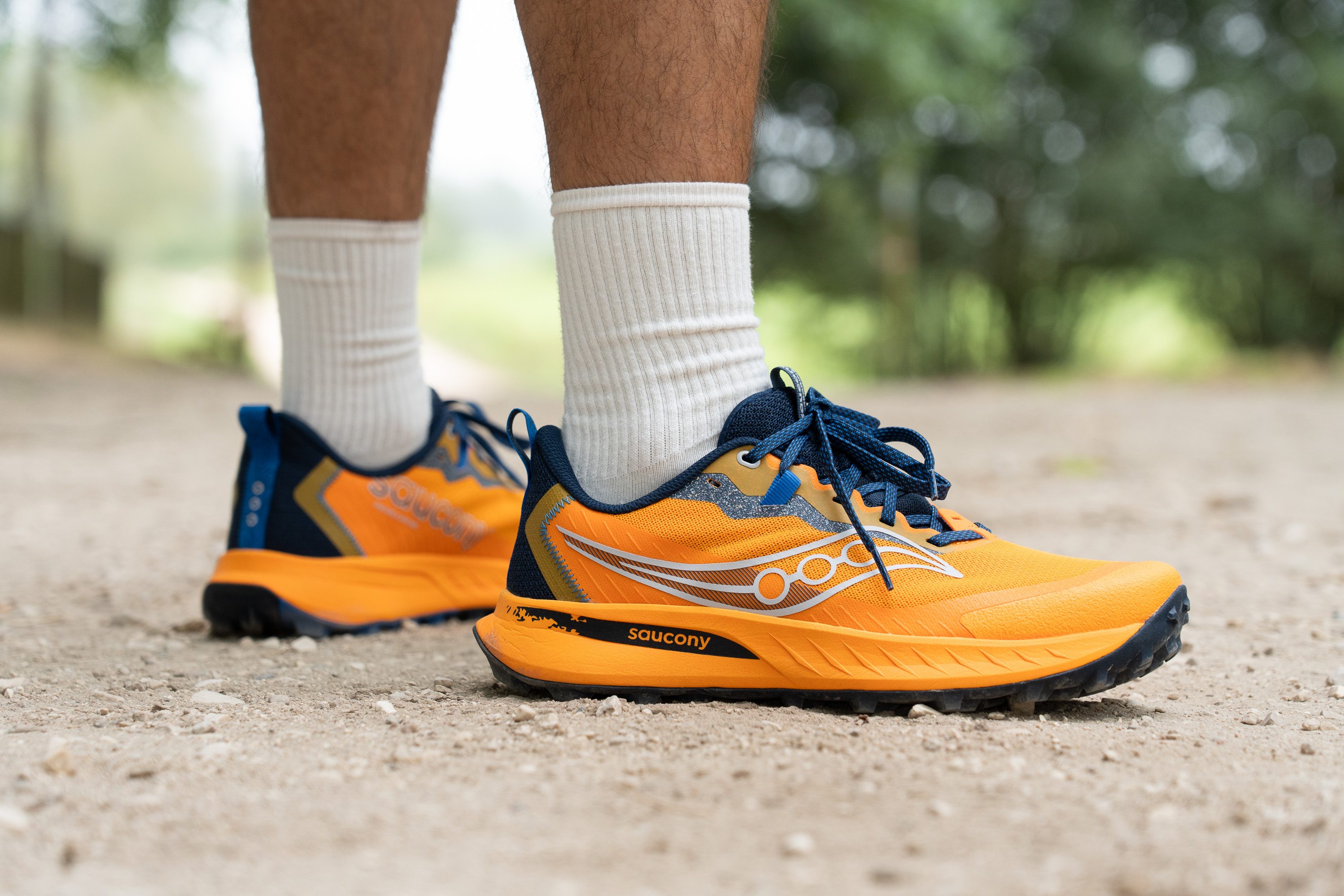
Who should NOT buy
We believe that the biggest drawback of the Peregrine 15 is its narrow, tapered toebox. In our experience, this can become a problem during multi-hour runs, especially for wide-footed runners or those prone to toe discomfort. For a more foot-shaped fit, we suggest the Topo Ultraventure 4 or the zero-drop Altra Lone Peak 9.
We’re also convinced that the 4 mm drop won’t suit heavy rearfoot strikers. If that sounds like you, we believe shoes like the ASICS Gel Trabuco 13 or the Nike Wildhorse 10 offer a more heel-striker-friendly alternative.

Cushioning
Shock absorption
We tested the shock absorption of the Peregrine 15 and found a result of 125 SA, which makes complete sense given that it’s far from being a maximalist trail shoe. It lands right around the average, delivering just enough cushion without compromising ground feel.

| Peregrine 15 | 125 SA |
| Average | 122 SA |
Energy return
We measured 60.4% energy return in the heel and 65.8% in the forefoot, both above the lab average. That’s great news for runners craving a responsive ride, and when you combine bounce and price, we found that this is one of the top-performing trail shoes out there.
| Peregrine 15 | 60.4% |
| Average | 55.6% |
Heel stack
It’s impressive how much shock absorption this shoe delivers with only 29.5 mm of stack height. In a market filled with new trail shoes pushing close to 40 mm, this feels like a perfect pick for lighter runners who don’t need an ultra-thick heel.
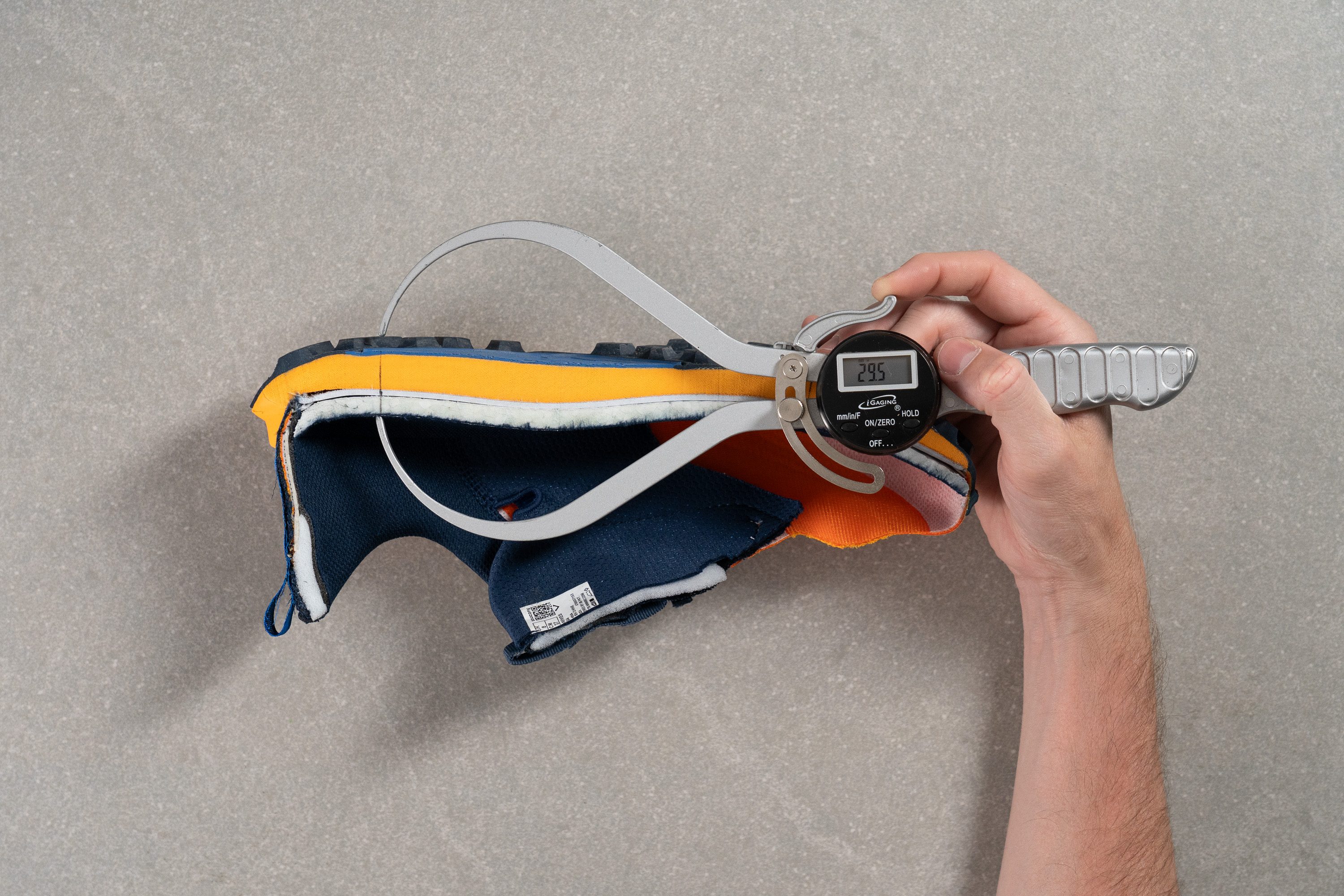
| Peregrine 15 | 29.5 mm |
| Average | 32.6 mm |
Forefoot stack
The forefoot offers plenty of stack to handle most runs, and as shown, it sits quite close to the heel. Using our calipers, we measured a total height of 25.8 mm.
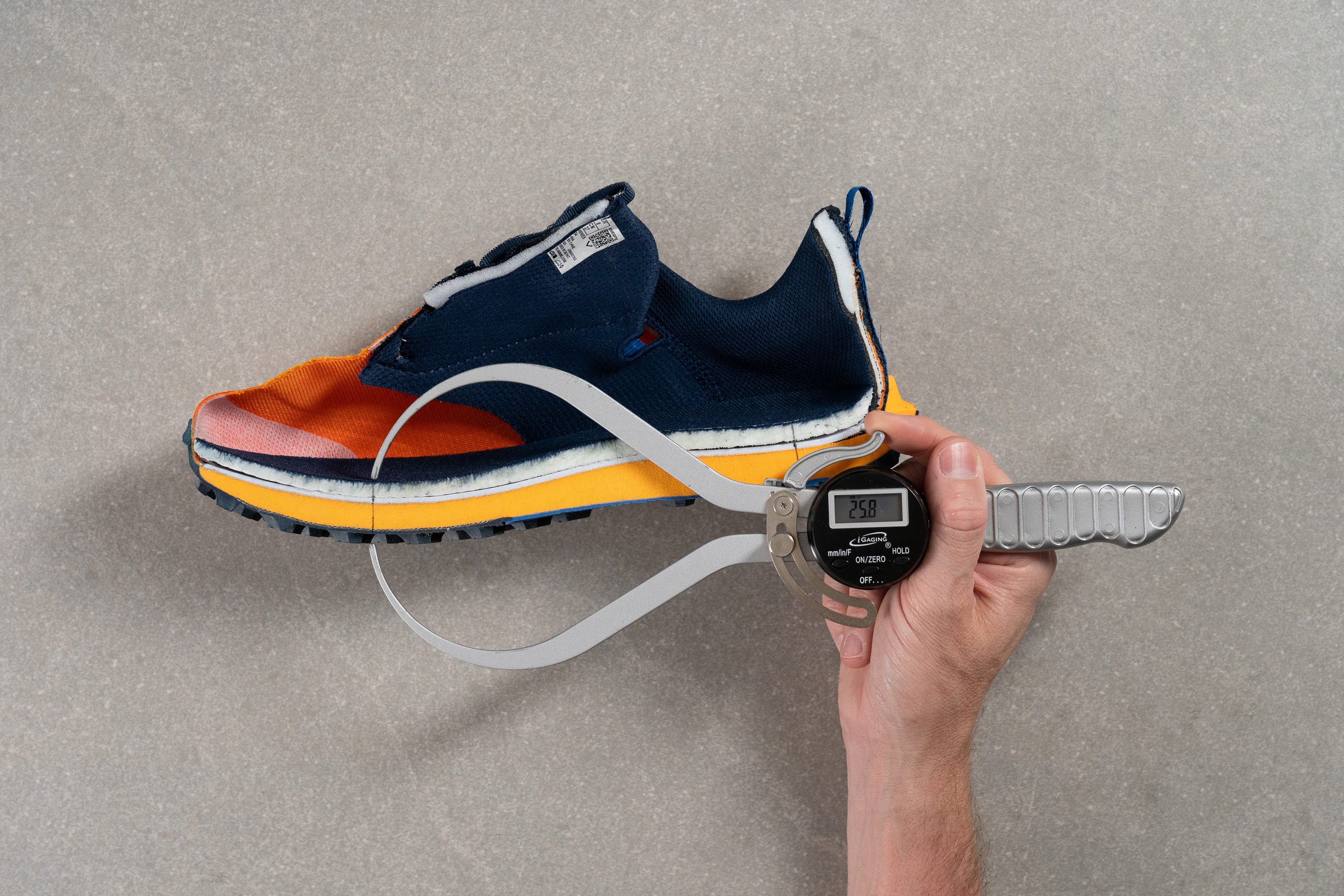
| Peregrine 15 | 25.8 mm |
| Average | 25.1 mm |
Drop
One standout feature we tested in the Peregrine 15 is its low-drop geometry, something rarely seen in a big-brand trail shoe.
We discovered just 3.7 mm of difference between heel and forefoot, making it a strong pick for forefoot and midfoot strikers. Heel strikers might still enjoy the ride, but those with a heavy landing may not find it as smooth-flowing as in a higher-drop option.
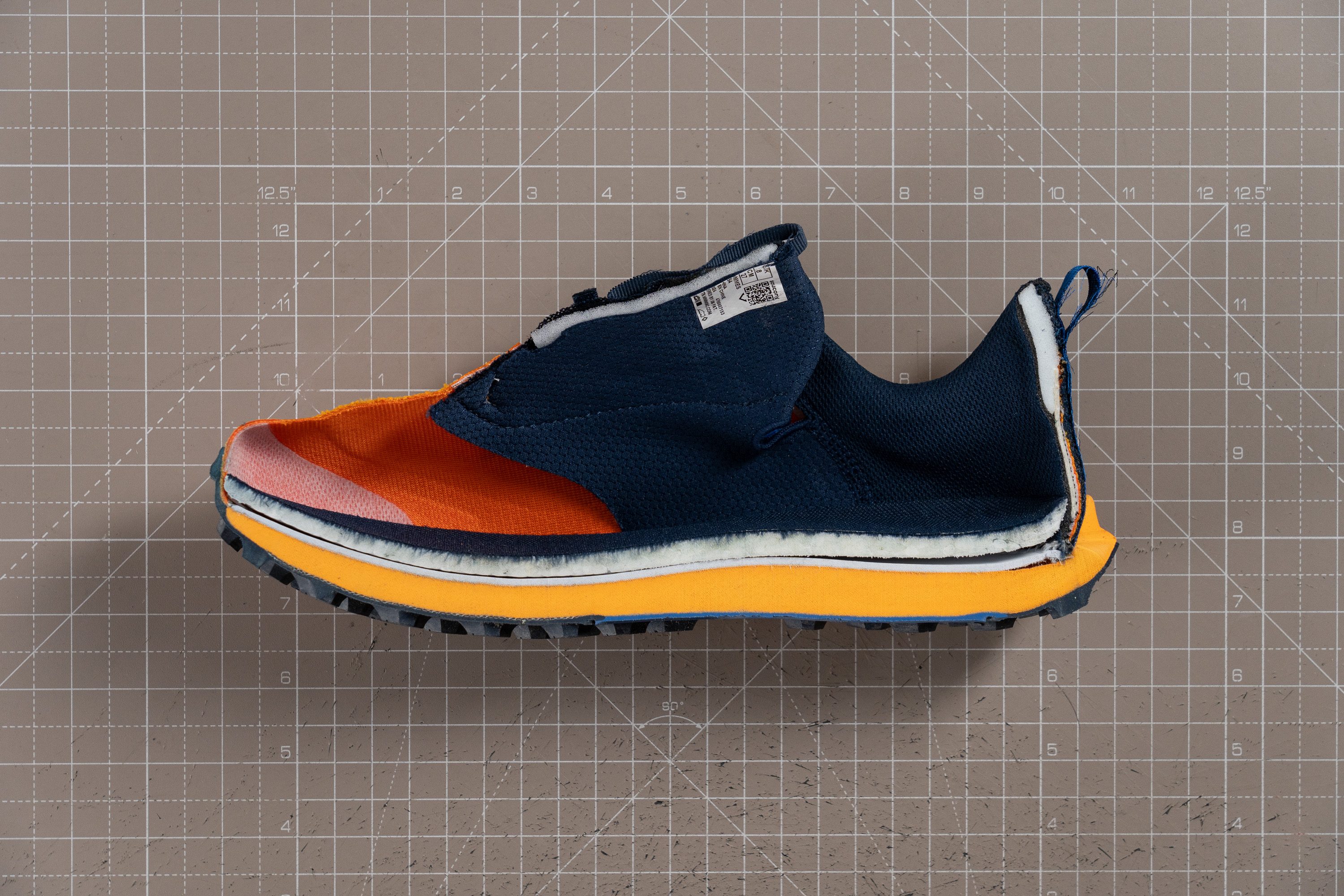
| Peregrine 15 | 3.7 mm |
| Average | 7.5 mm |
Midsole softness
We discovered last year that the Peregrine 14 felt overly firm. This time, Saucony took a different route, switching to a much softer PWRRUN foam with a 14.9 HA reading instead of the previous 26.0 HA, marking a bold 42% shift.
This upgrade makes the ride noticeably smoother and easier on the legs. Those who prefer a firm-and-stable feel can still grab the older version (likely at a nice discount) but for everyone else, the new midsole brings a more comfortable experience.
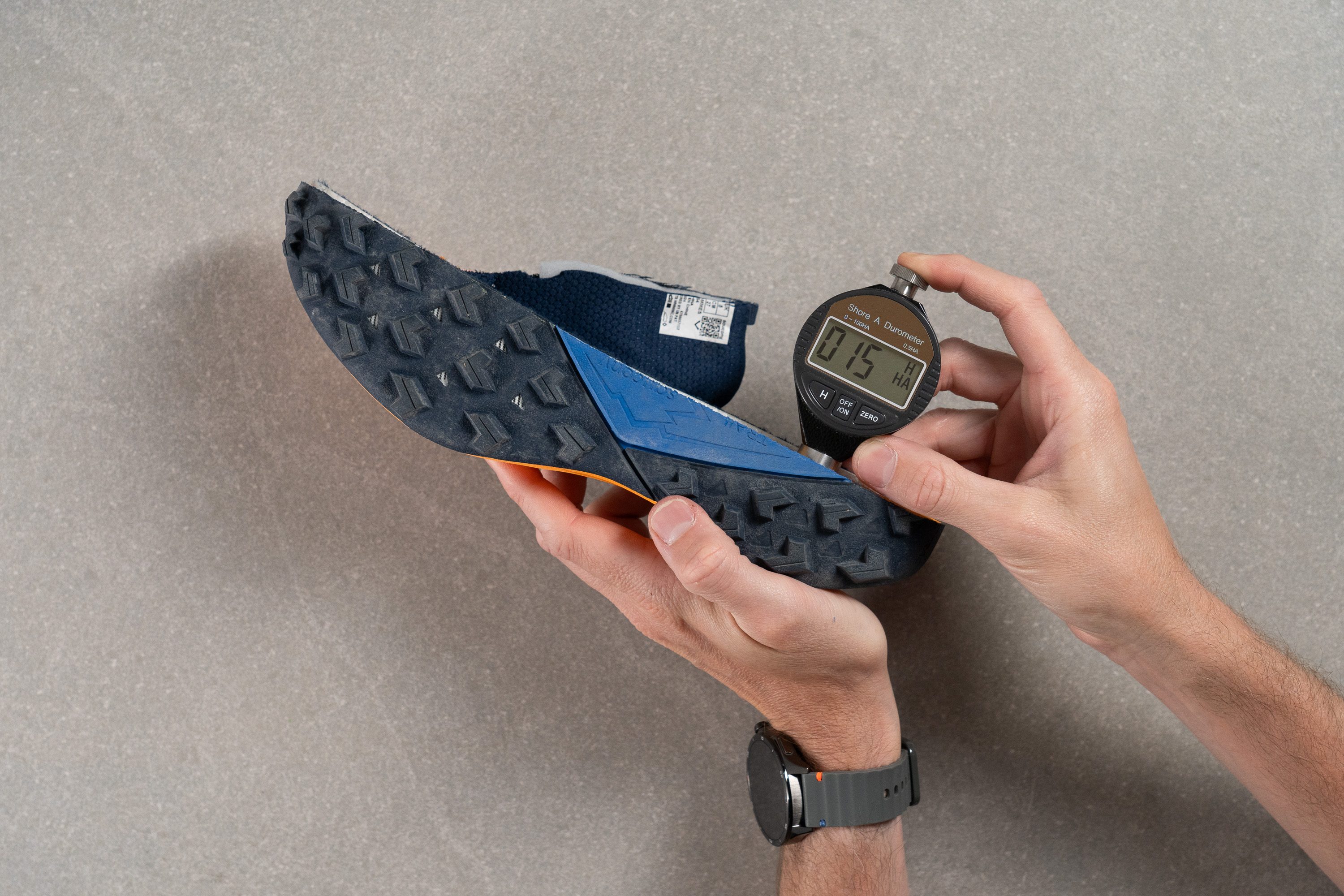
| Peregrine 15 | 14.9 HA |
| Average | 21.9 HA |
Rocker
The Peregrine 15 uses Saucony’s Speedroll rocker to deliver a smooth, forward-rolling transition. While not as aggressive as road models, it adds a natural feel that's especially helpful for heel strikers.

Plate
We discovered that the Peregrine 15 features a plastic-based rock plate positioned only in the forefoot, visible through small cutouts in that zone. It’s a lightweight, plastic piece that adds protection where it matters most, and it's especially useful for runners tackling rocky trails.
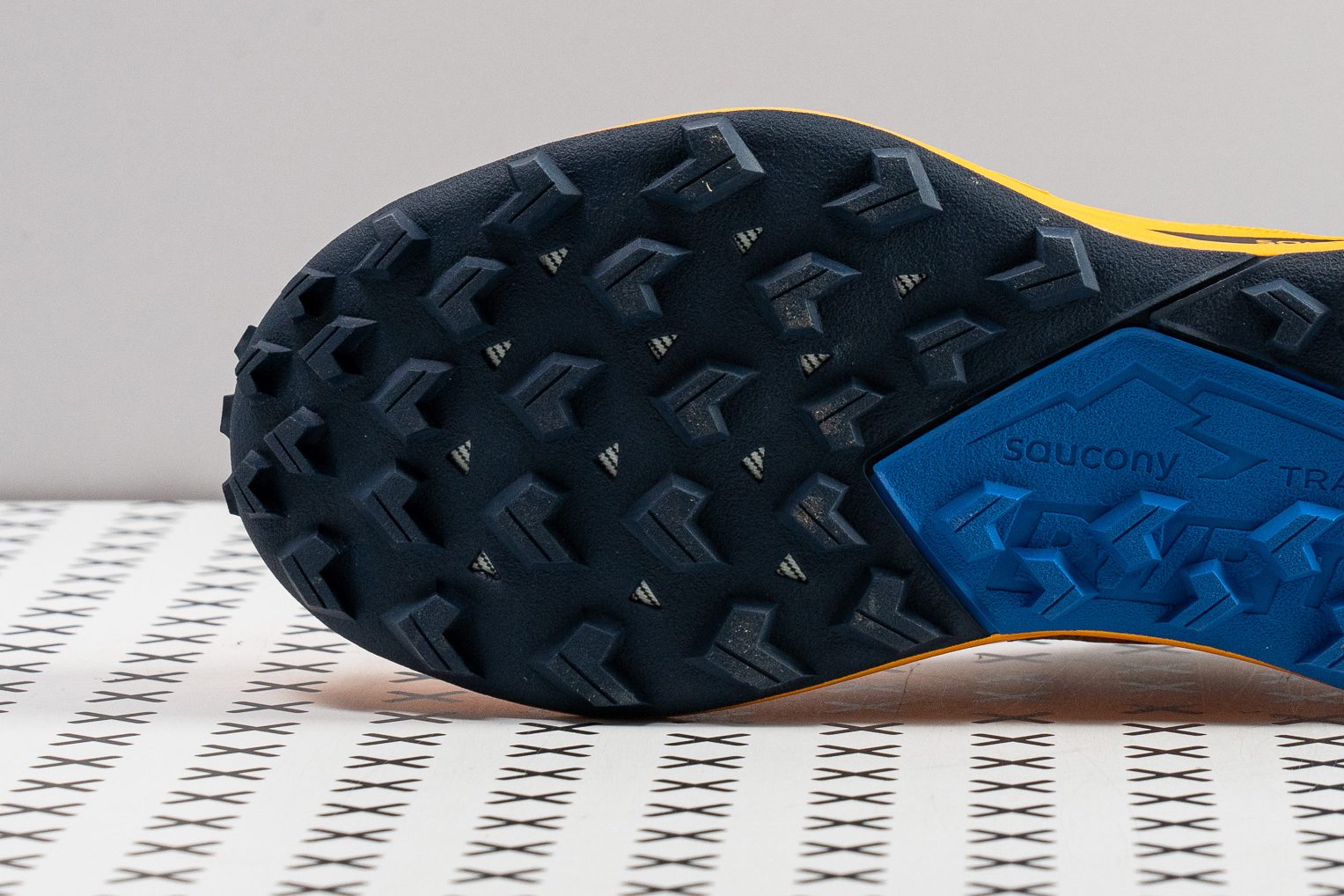
Size and fit
Size
Saucony Peregrine 15 fits true to size (18 votes).
Width / Fit
The fit of the Peregrine 15 feels similar to earlier versions when we tried them on. Still, we prefer to measure things precisely, so we pulled out the gel mold and took our first width reading: 95.5 mm.
That puts it right around the average compared to other trail running shoes. But let's keep digging!
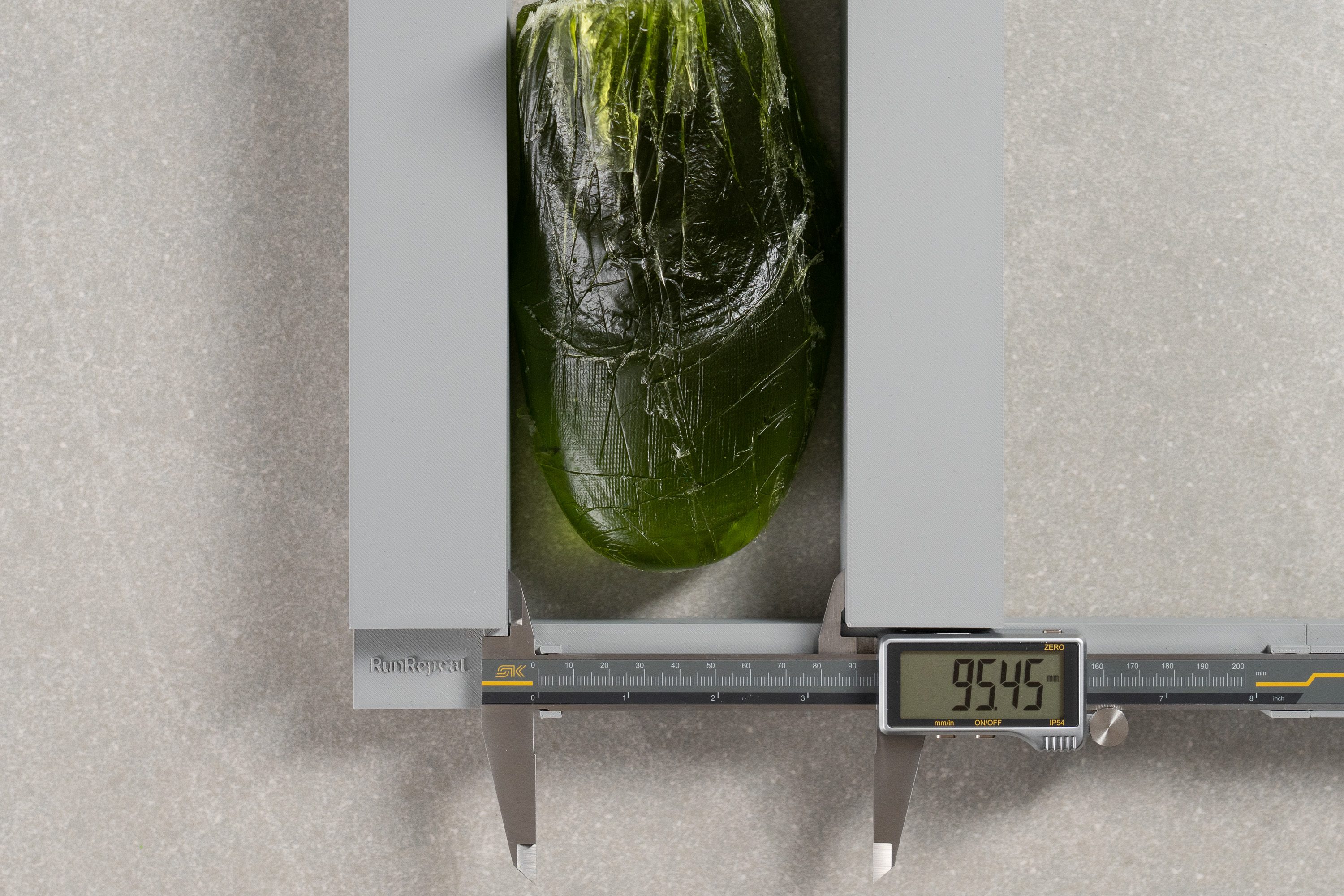
| Peregrine 15 | 95.5 mm |
| Average | 95.7 mm |
Toebox width
Our second measurement was key to understanding the Peregrine 15’s fit. Saucony kept the same tapered shape seen in the 14, with just 70.9 mm of width in the toebox.
It’s a narrow design, definitely not ideal for wide-footed runners looking for extra room up front.
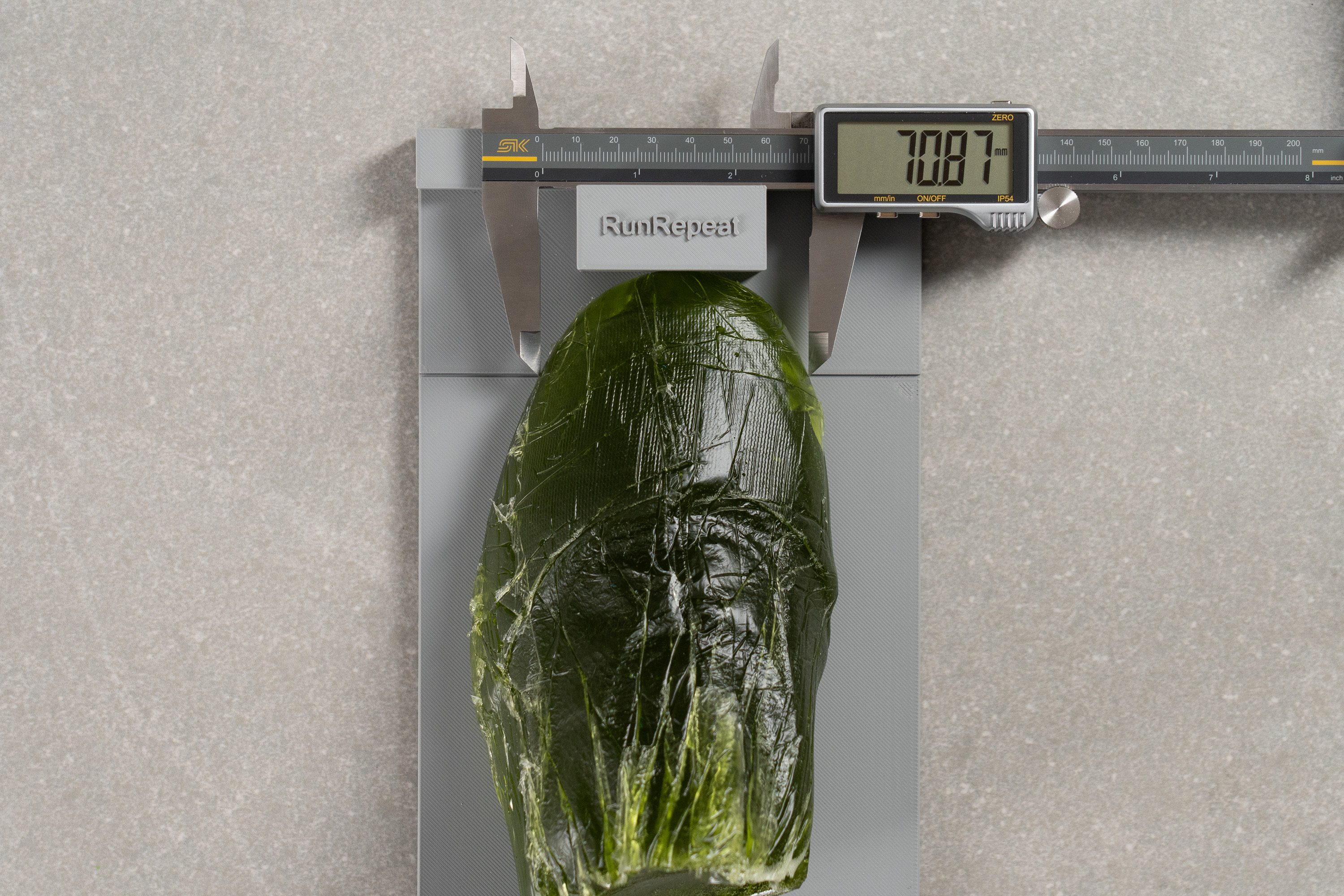
| Peregrine 15 | 70.9 mm |
| Average | 74.7 mm |
Toebox height
In contrast to the narrow toebox width, we found a generous toebox height of 28.2 mm.
This added vertical space gives your toes room to breathe, making it a great match for long trail efforts.
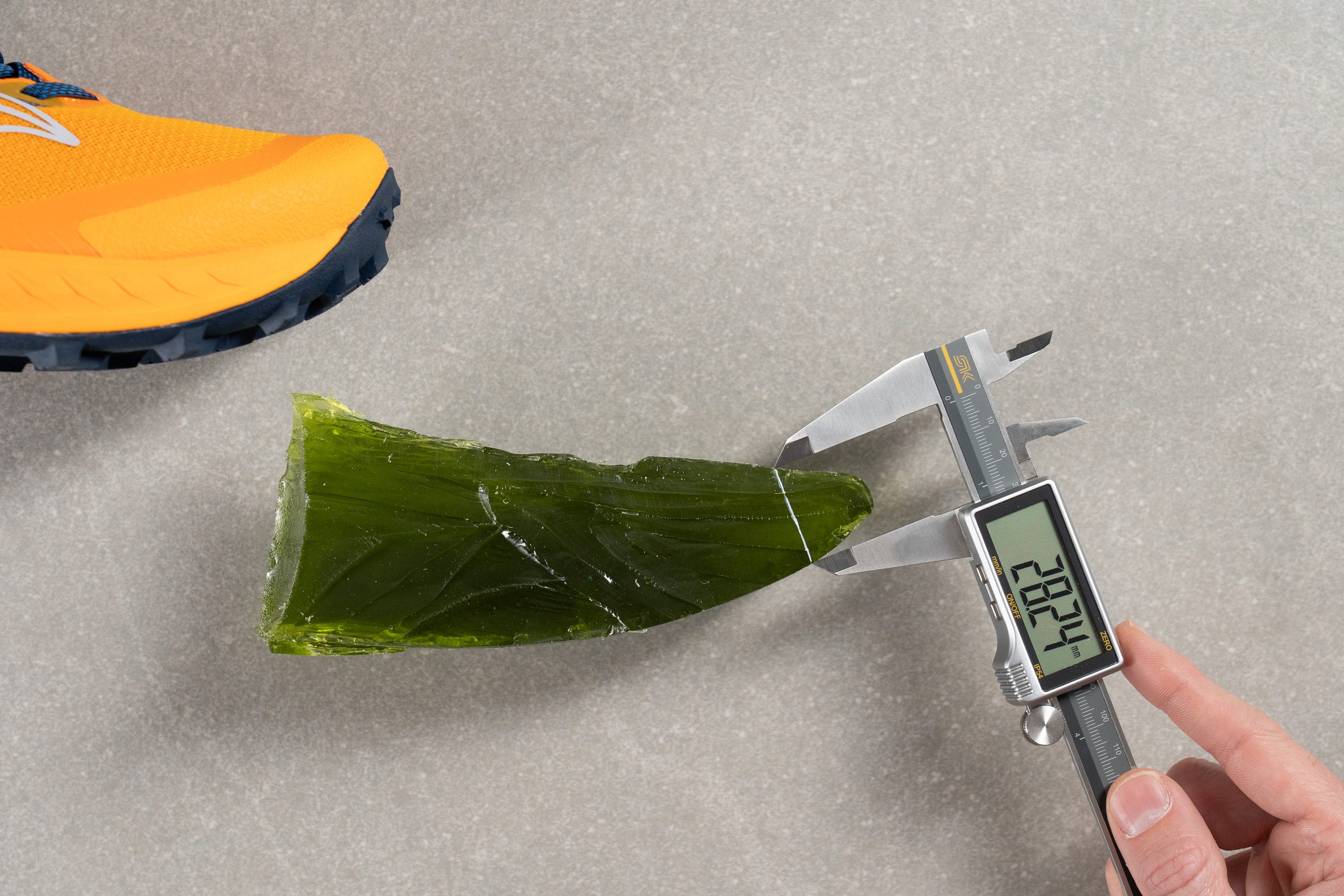
| Peregrine 15 | 28.2 mm |
| Average | 27.1 mm |
Traction / Grip
Lug depth
The Peregrine stays true to its roots with aggressive lugs. While it might’ve been tempting for Saucony to shrink them to 3 or 3.5 mm for added versatility, they stuck with 4.7 mm chevron-shaped lugs instead.
We appreciate this decision. Plenty of new trail shoes go with small lugs, but the Peregrine strikes a better all-terrain balance.

| Peregrine 15 | 4.7 mm |
| Average | 3.5 mm |
Outsole design
The Saucony Peregrine 15 outsole features a full-length PWRTRAC rubber compound in two contrasting colors with clear segmentation between the forefoot and rearfoot.
It has 31 lugs positioned in alternating directions, using rear-facing patterns at the heel for braking and forward-facing ones at the forefoot to support push-off and climbing.

Flexibility / Stiffness
Good news here, as the Peregrine 15 shows impressive flexibility given its stack height and full-length outsole. We measured just 11.1N in our lab test, which comes in well below the average and confirms its easy-bending structure.
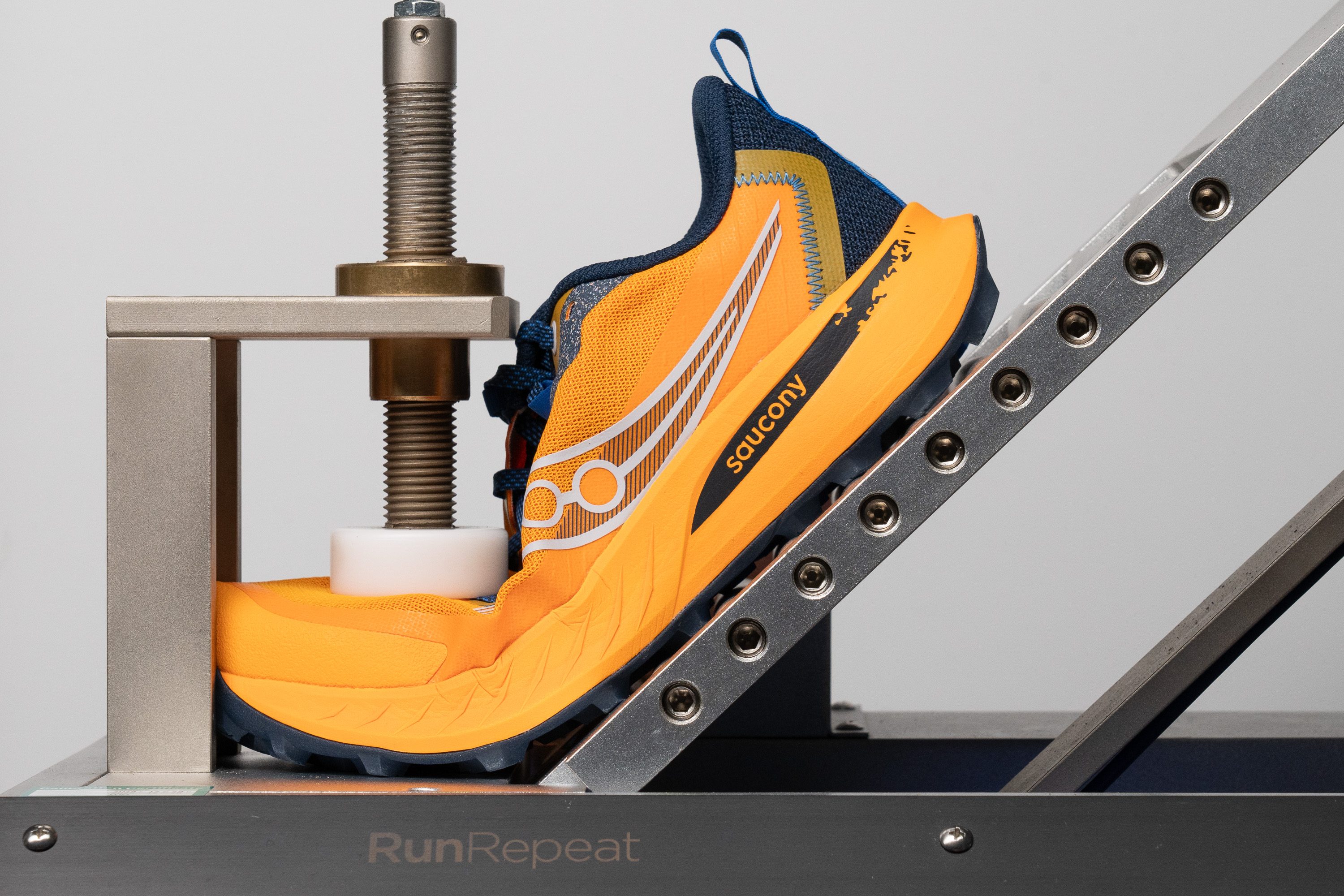
| Peregrine 15 | 11.1N |
| Average | 14.6N |
Weight
The Peregrine 15 ticks another box, as it keeps exactly the same weight as its predecessor: 9.4 oz or 266g. We tested both side by side and found no change at all on the scale.
That’s a strong result. In fact, it’s one of the rare trail models that manages a comfort-driven feel without adding a lot of weight.

| Peregrine 15 | 9.4 oz (266g) |
| Average | 10.2 oz (289g) |
Breathability
At first glance, the upper of the Peregrine 15 looks rugged and trail-ready, built more for harsh conditions than airflow. Still, we connected it to our smoke machine using a 3D-printed tool that directs smoke into the toebox to check how well it expels warm air.
After running the test, we recorded a 3/5 score. That’s a solid result for a trail shoe and suggests good year-round comfort. For summer runs, we recommend pairing it with thin, moisture-wicking socks to stay cool and dry.
Next, we examined the upper over a bright light to better assess its design. It’s clear that Saucony went for a structured-and-supportive build in the heel and midfoot, with only the front section focused on ventilation.

Under the microscope, we discovered that the engineered mesh is nothing out of the ordinary.
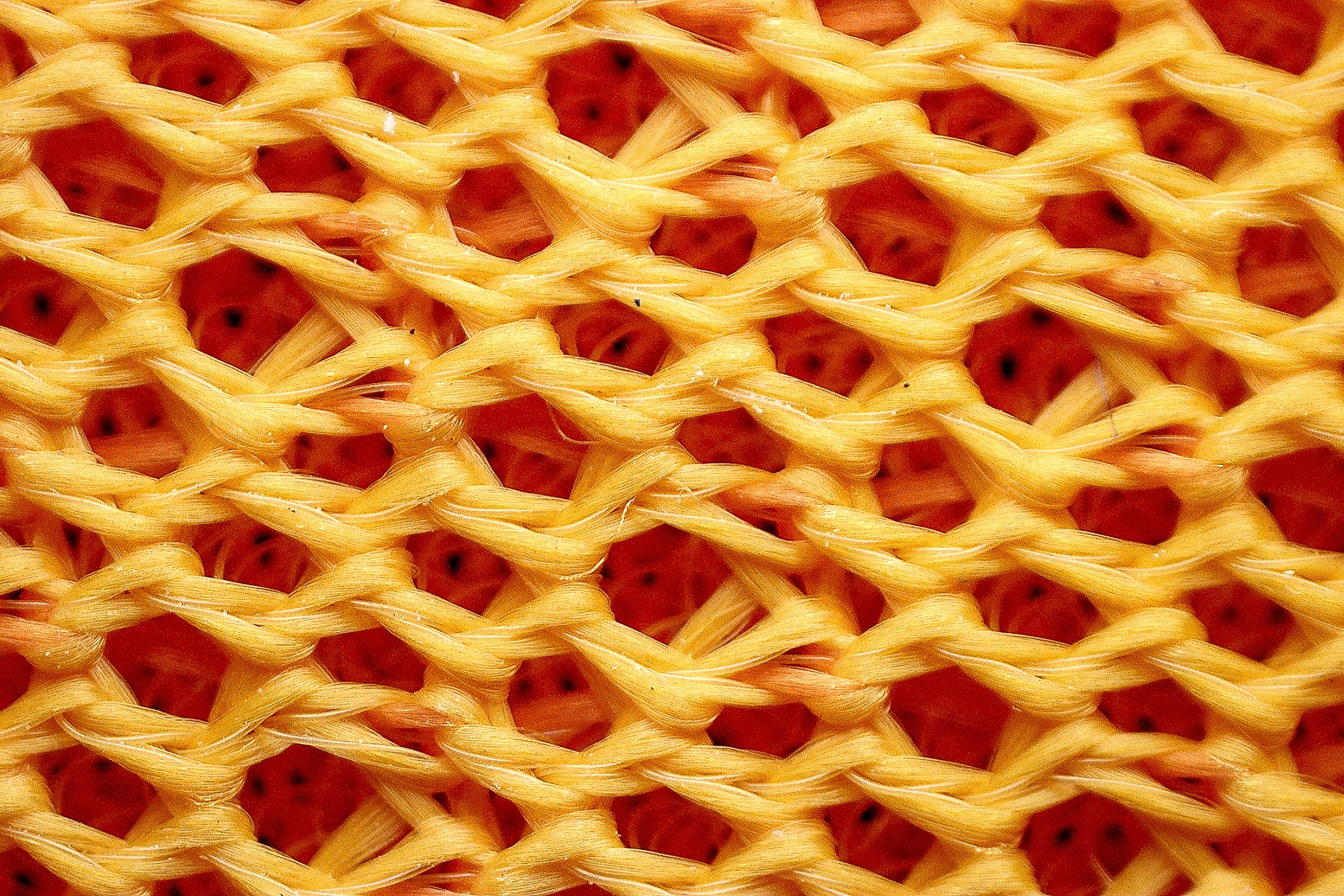
We’ve seen plenty of similar designs in the lab, which isn’t a downside. If it works well, there's no need for change.
We appreciated the upper’s comfort-protection mix, with a balance that leans slightly toward durability. It's a no-nonsense setup that fully fits the identity of this shoe.
| Peregrine 15 | 3 |
| Average | 3.2 |
Stability
Lateral stability test
Considering the softer foam in the Peregrine 15, we expected a drop in stability compared to v14. Still, we discovered that it holds up well overall.
We found that support takes a minor hit, but nothing that feels like a dealbreaker. It's just a minor trade-off that most runners will likely find worthwhile.
Torsional rigidity
Just like in our longitudinal stiffness test, we were glad to see that Saucony didn’t go overboard with stiffness. The Peregrine 15 remains easy to bend and twist with a 2/5 score, which adds to its comfort and makes it hike-friendly too.
| Peregrine 15 | 2 |
| Average | 3.6 |
Heel counter stiffness
The heel counter feels similar to what we usually find in road daily trainers, scoring 3/5 on our scale. It’s clearly structured, yet nicely padded and well-protected, offering support without causing any discomfort.
| Peregrine 15 | 3 |
| Average | 3 |
Midsole width - forefoot
Aside from the softer PWRRUN foam, the biggest change in the Peregrine 15 compared to its predecessor comes from its updated dimensions. The forefoot now measures 117.0 mm, noticeably wider than the 112.3 mm we recorded last year.
That added width helps explain why, even with the softer foam, the shoe didn’t feel as unstable as we expected.
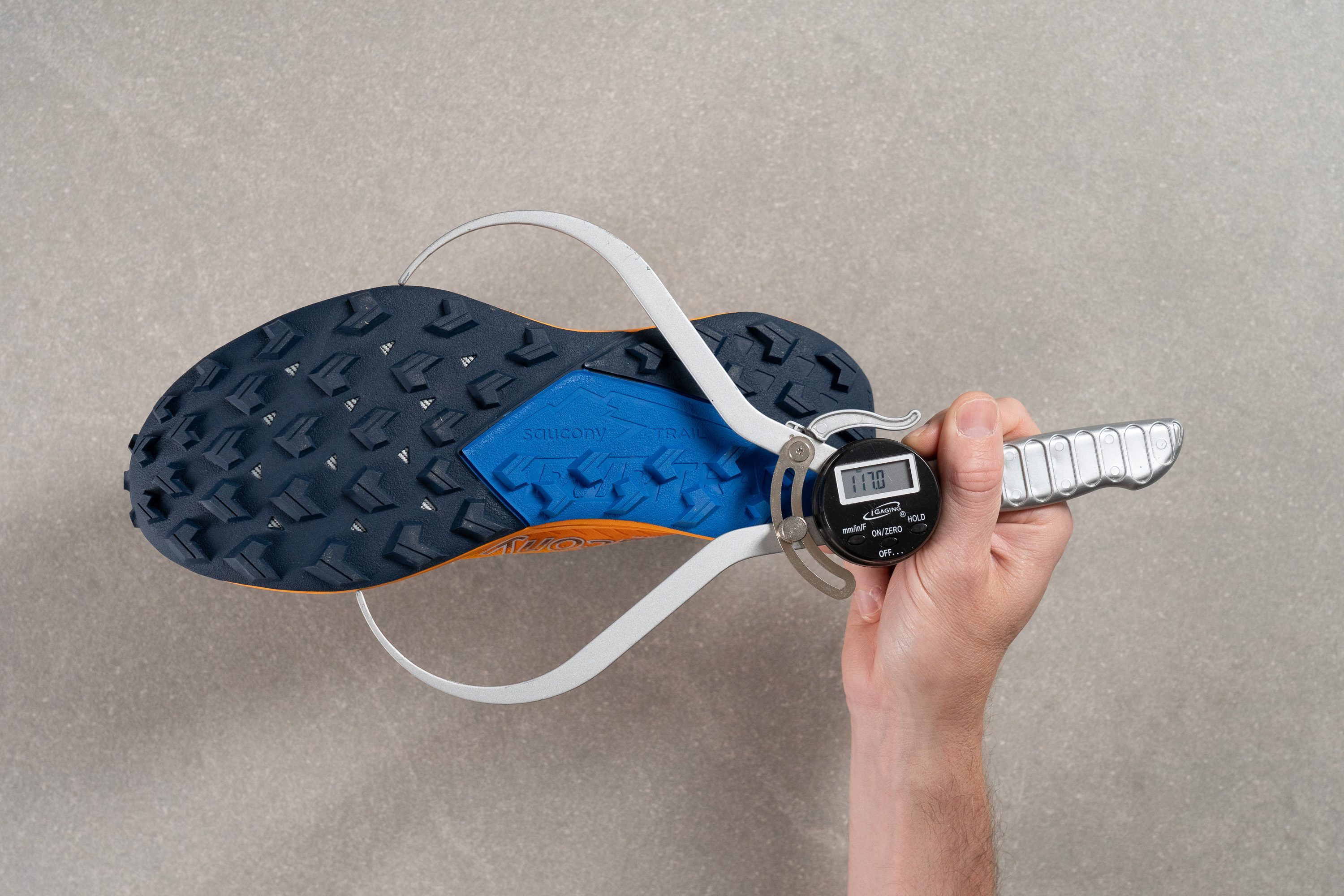
| Peregrine 15 | 117.0 mm |
| Average | 112.8 mm |
Midsole width - heel
The same applies to the heel, which increased from 85.9 mm to 90.5 mm in this fifteenth version. We see this as a positive update, especially beneficial for heel strikers looking for a broader landing platform.

| Peregrine 15 | 90.5 mm |
| Average | 89.9 mm |
Durability
Toebox durability
Durability is a key factor in any trail running shoe, so we were eager to test the Peregrine 15. After powering up the Dremel and applying it to the upper, we found it held up impressively well, earning a solid 4/5 score.
| Peregrine 15 | 4 |
| Average | 3.1 |
Heel padding durability
The heel padding also earned a good score in our test, even if a 3/5 wasn’t particularly outstanding. Still, the key takeaway is that it showed no weakness and it's definitely not a drawback.
| Peregrine 15 | 3 |
| Average | 3 |
Outsole durability
The PWRTRAC outsole also faced the Dremel test, showing 0.9 mm of wear and being right in line with the lab average. It’s not a concern, especially given the shoe’s deep lugs.
| Peregrine 15 | 0.9 mm |
| Average | 0.9 mm |
Outsole thickness
The outsole measures just 1.2 mm in thickness, likely to reduce weight. Since the Peregrine 15 includes a rock plate, Saucony can rely on it for underfoot protection and use less rubber without compromising safety.

| Peregrine 15 | 1.2 mm |
| Average | 2.2 mm |
Misc
Insole thickness
One of the hidden details in the Peregrine 15 is the insole, because it’s not the standard type found in most shoes. This one is thicker at 6.9 mm and made from TPU-based PWRRUN+ instead of regular EVA. Funny enough, the insole foam actually is more premium than the midsole itself!
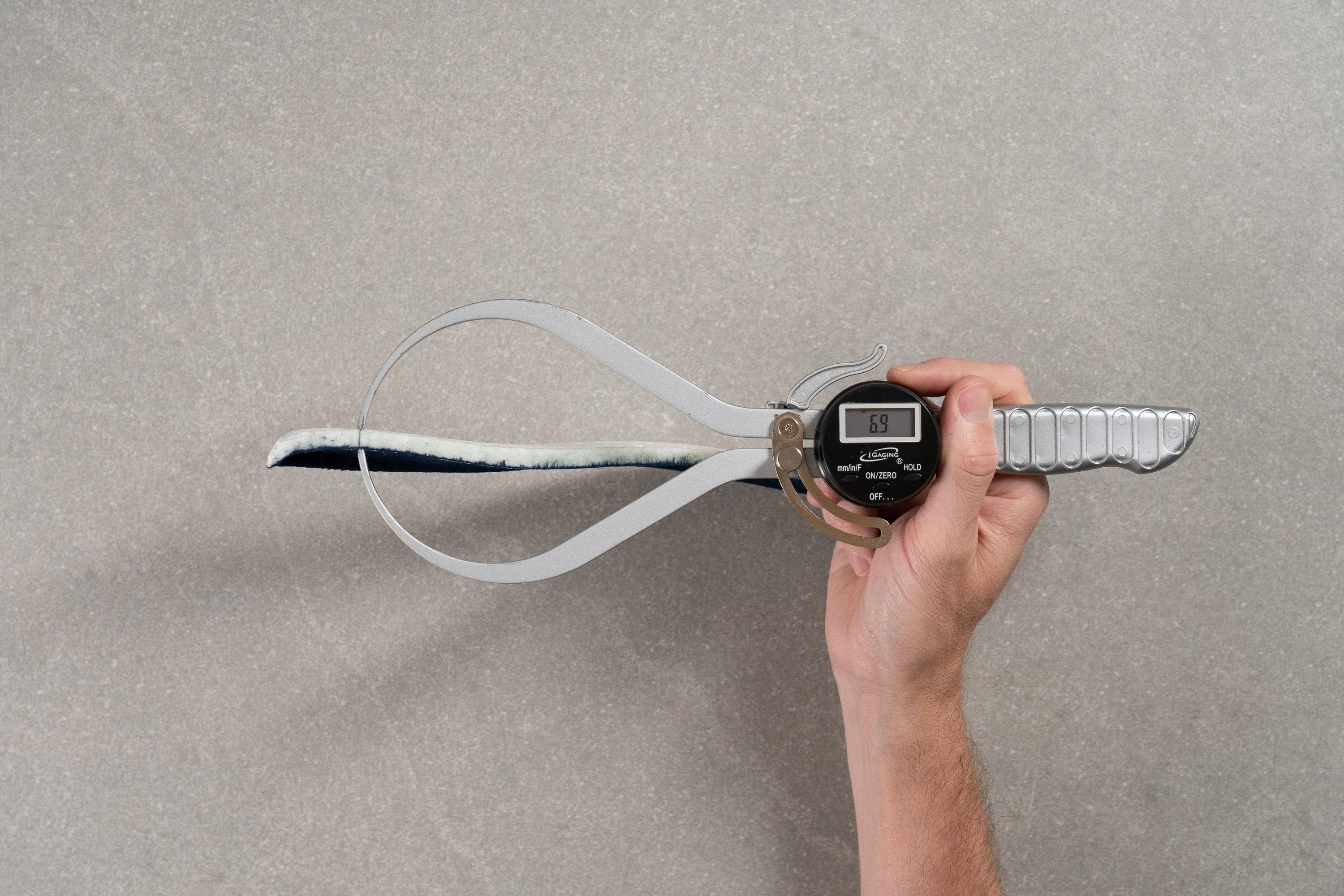
| Peregrine 15 | 6.9 mm |
| Average | 4.7 mm |
Removable insole
You can remove the FormFit insole if you prefer a firmer feel or want to use your favorite insert. However, that means giving up one of the shoe’s standout features, since the stock insole is made from PWRRUN+ as mentioned earlier.
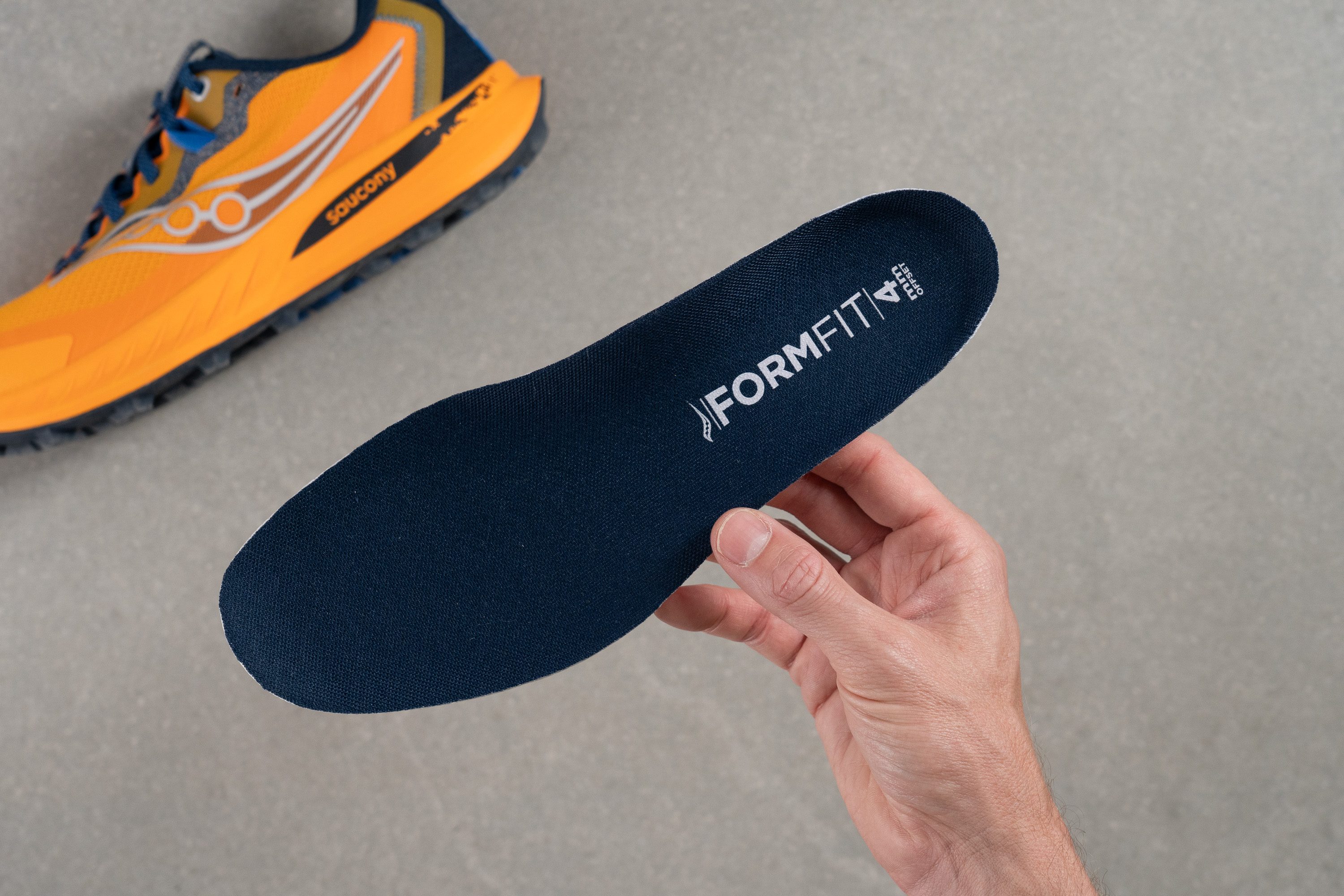
| Peregrine 15 | Yes |
Midsole softness in cold (%)
We placed the Peregrine 15 in the freezer for 20 minutes to see how it handles cold conditions. It became only 22% firmer, which is a pretty decent result and suggests solid temperature resistance.
| Peregrine 15 | 22% |
| Average | 26% |
Reflective elements
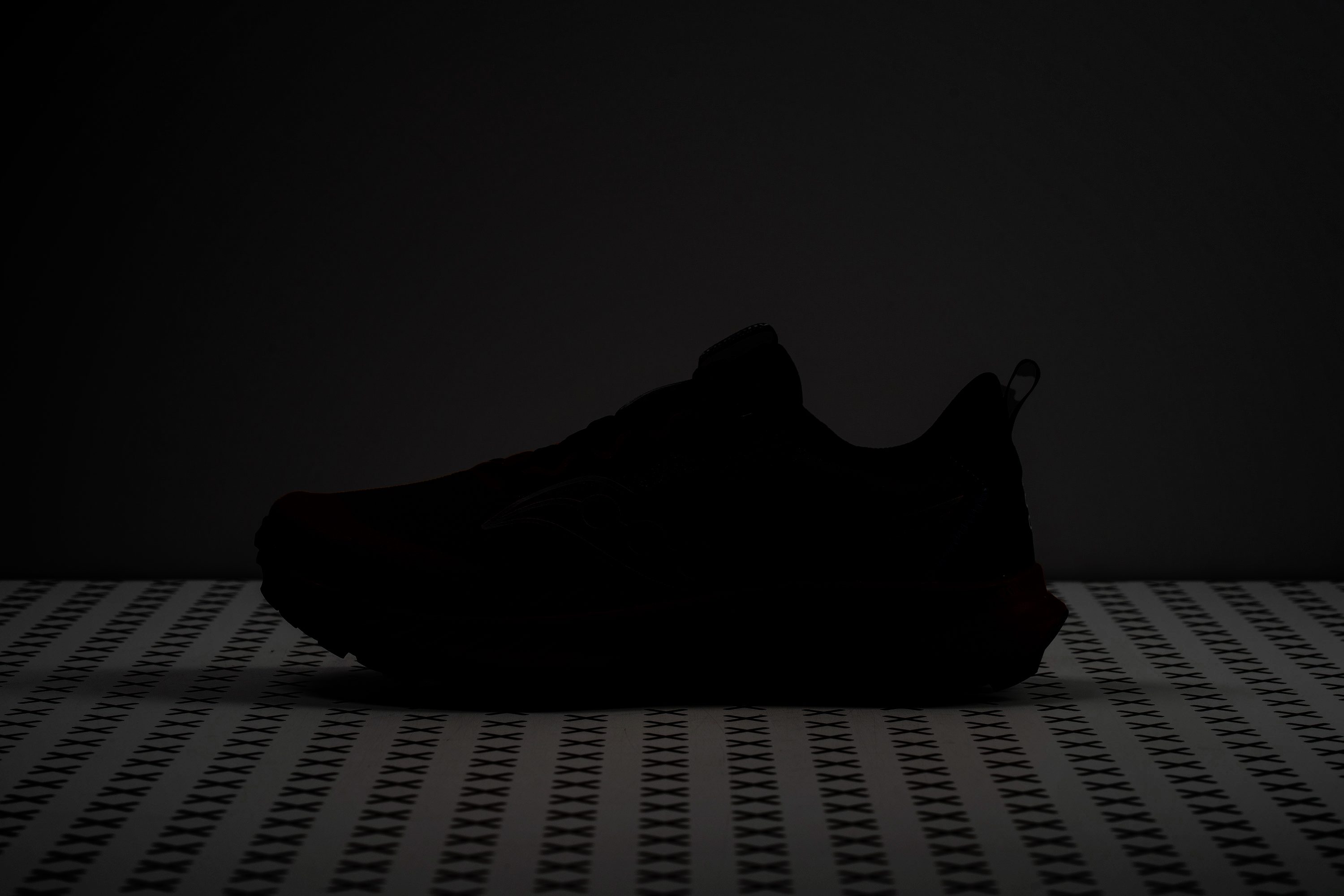
Tongue padding
The tongue of the Peregrine 15 comes with 6.0 mm of padding. In our experience, that's enough even for those tackling day-long hikes or ultra runs.
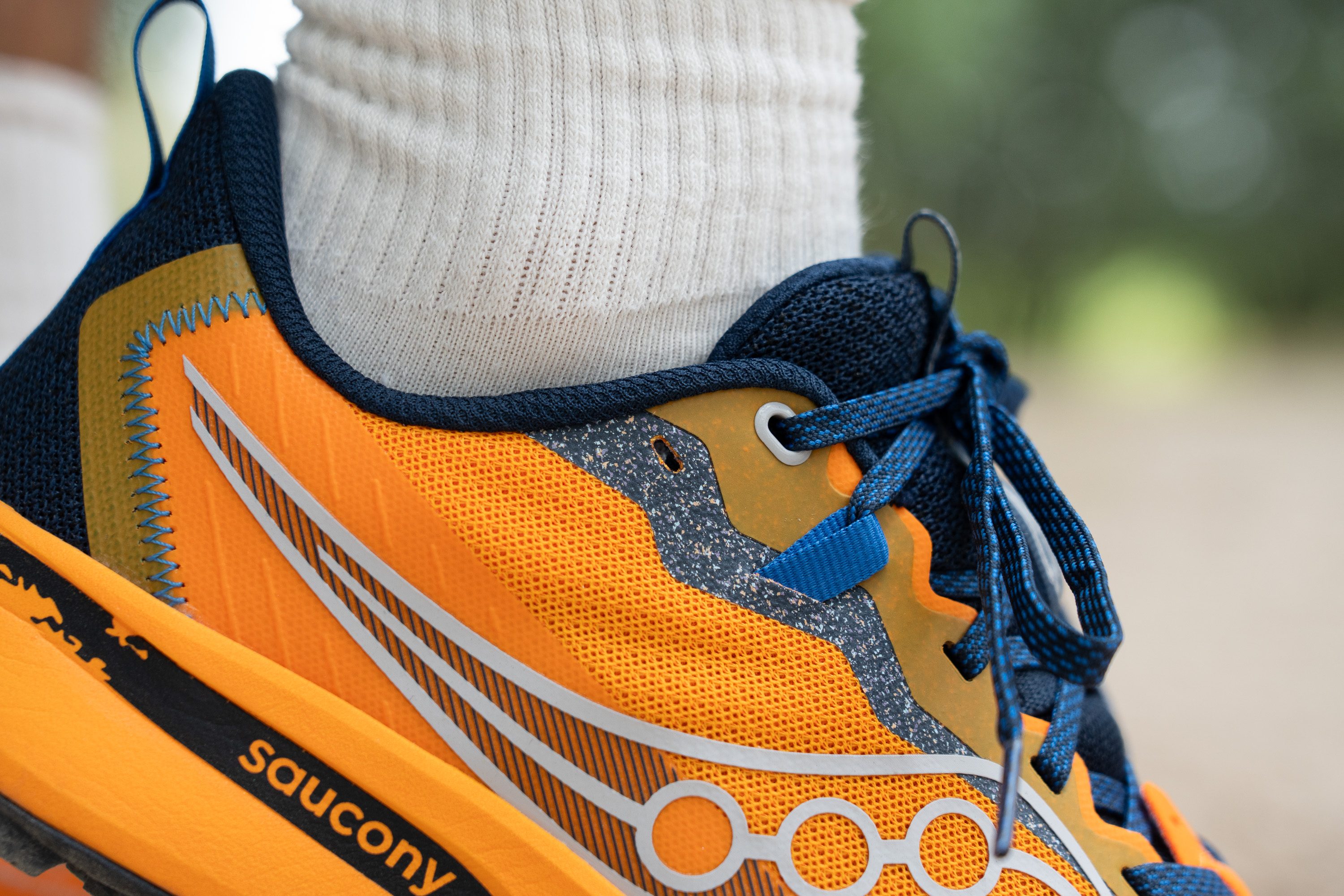
We also found that the Peregrine 15 features a simplified lacing system compared to version 14. In this update, Saucony uses only one blue fabric loop on each side to improve lockdown. In the previous version, there were two of these loops per side, which added more complexity to the design.
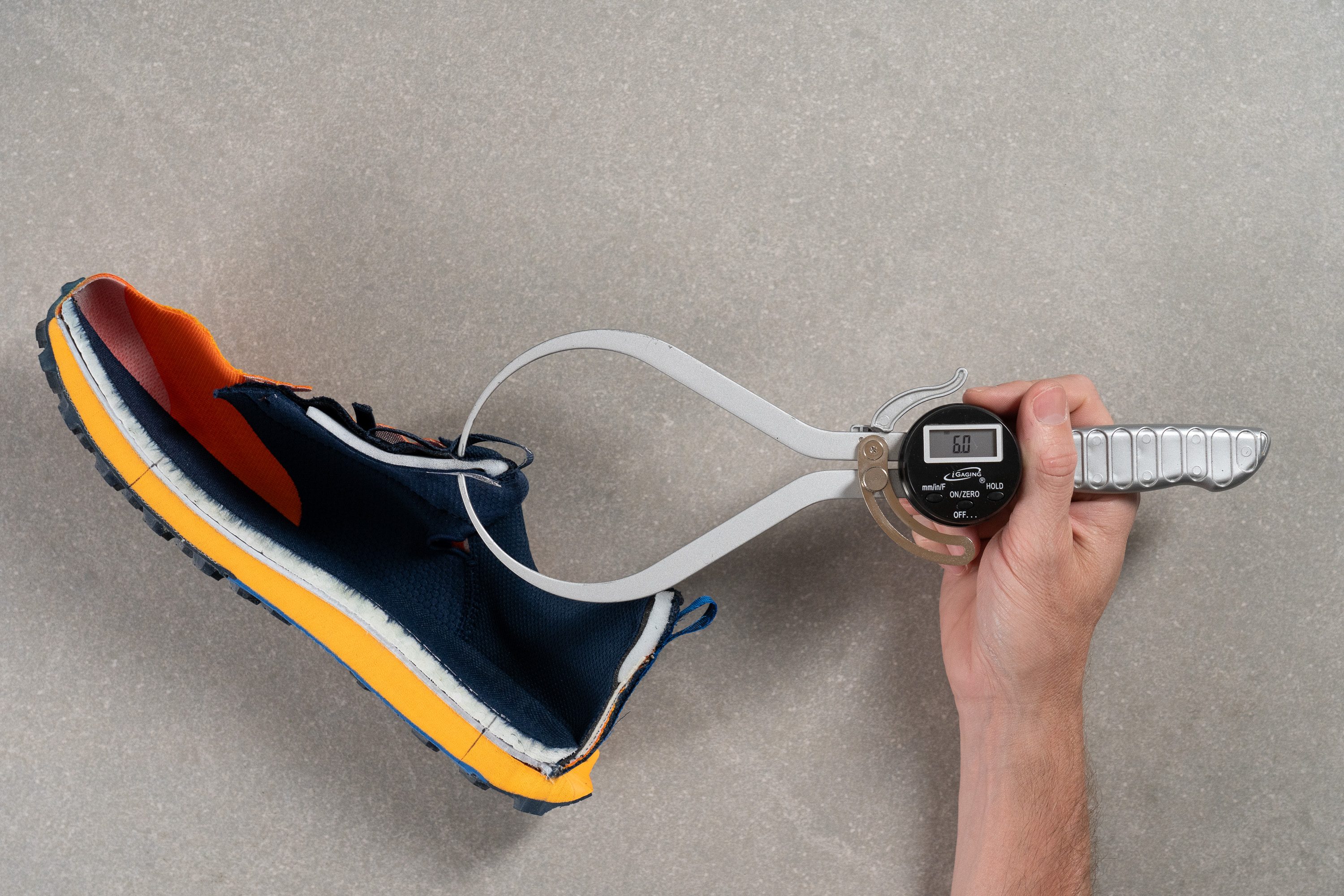
| Peregrine 15 | 6.0 mm |
| Average | 6.4 mm |
Tongue: gusset type
The tongue is stitched to the sides, which is always a welcome detail in a trail shoe.
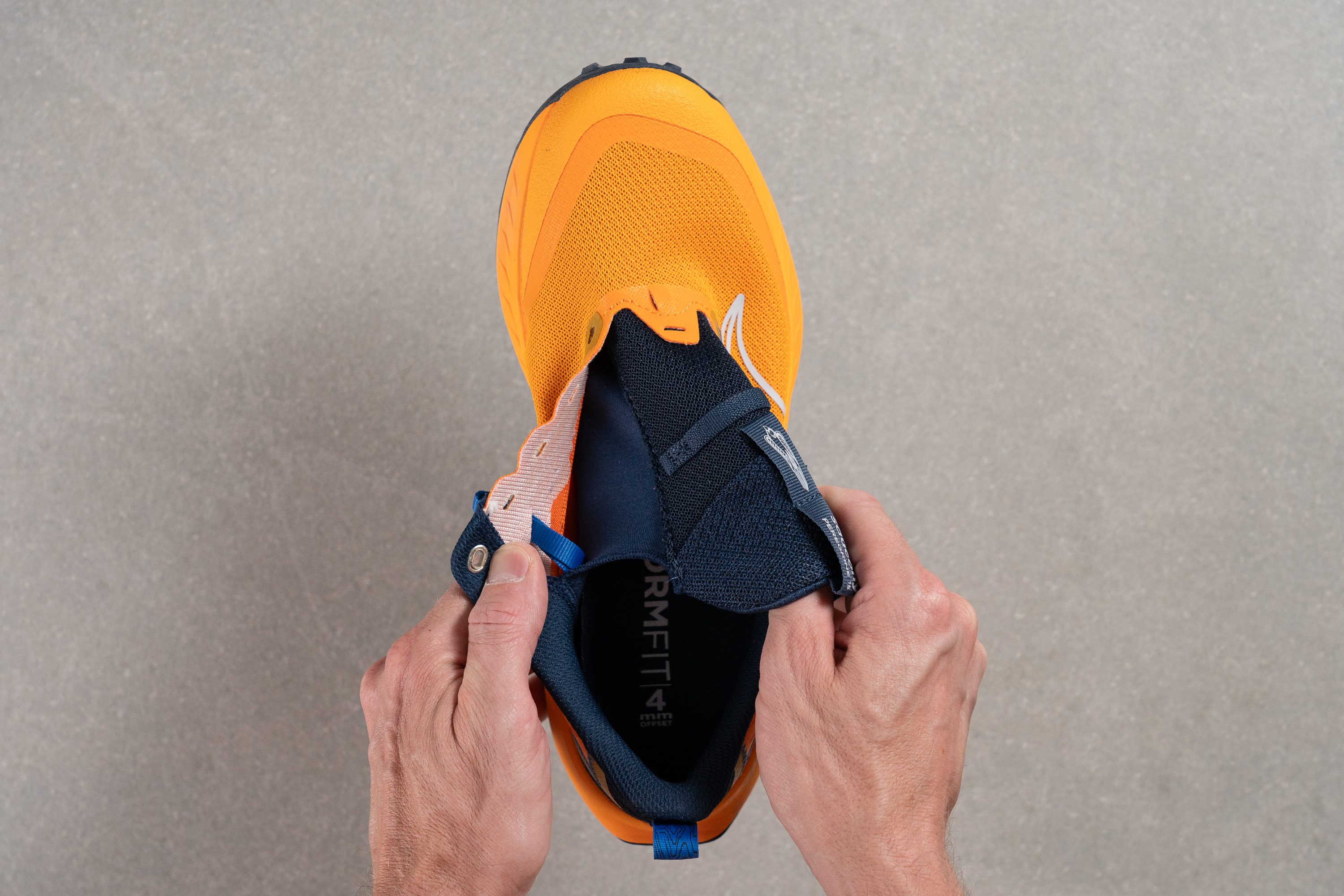
| Peregrine 15 | Both sides (semi) |
Price
One of the standout features of the Peregrine 15 is its reasonable price point, right in line with the best-selling road daily trainers. Trail models often come with a premium, so we were glad to see that this version didn’t get a price bump like others and remains a fair-value option.
| Peregrine 15 | $140 |
| Average | $153 |
Heel tab
There’s a simple-but-functional finger-loop heel tab that gives the shoe a more trail-ready look. It’s reinforced with solid stitching, and we don’t expect it to come loose with regular use.
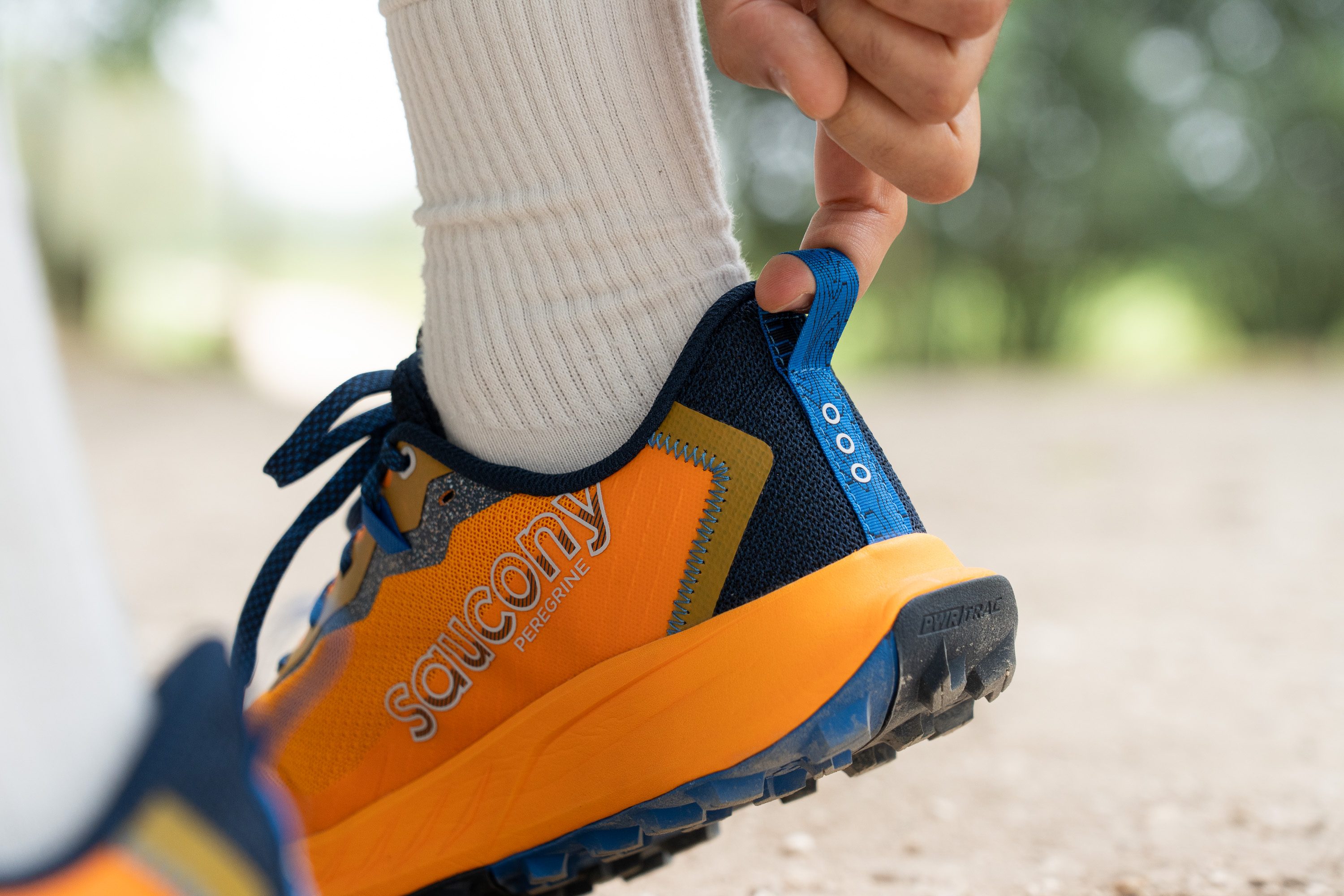
| Peregrine 15 | Finger loop |

